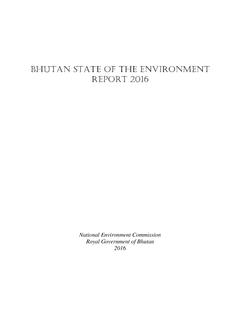Transcription of PRISM datasets aug2016 - PRISM Climate Group, Oregon …
1 1 Descriptions of PRISM Spatial Climate datasets for the Conterminous United States Created June 2013 Last revised August 2016 Summary of August 2016 revisions: Creation of LT81m, AN81m, and AN81D versions of Vpdmin and Vpdmax (minimum and maximum vapor pressure deficit) Addition of NCECONET (North Carolina), DEOS (Delaware), and NJWXNET (New Jersey) station networks The PRISM Climate Group works on a range of projects, some of which support the development of spatial Climate datasets . The resulting array of datasets reflects the range of project goals, requiring differing station networks, modeling techniques, and spatial and temporal resolutions.
2 Whenever possible, we offer these datasets to the public, either free of charge, or for a fee, depending on the size and difficulty of delivering the dataset and funding for the activity. In order for users to make informed decisions about which dataset is most appropriate for their needs, this document provides information on the PRISM spatial Climate datasets currently available. We start with an overview of the array of PRISM datasets , then discuss each in turn. Summary tables are provided for quick reference. It should be noted up front that these datasets are not static entities, but are in a constant state of change.
3 New networks are being added periodically to some datasets . Even those designed for long-term consistency experience changes due to improvements in data handling and quality control procedures. We will endeavor to keep this documentation current, but inconsistencies are bound to arise. Overview PRISM datasets provide estimates of six basic Climate elements: precipitation (ppt), minimum temperature (tmin), maximum temperature (tmax), mean dew point (tdmean), minimum vapor pressure deficit (vpdmin), and maximum vapor pressure deficit (vpdmax). Two derived variables, mean temperature (tmean) and vapor pressure (vpr), are sometimes included, depending on the dataset .
4 Descriptions of the Climate elements and derived variables are given in Table 1. 2 Table 1. Descriptions of Climate elements available from PRISM datasets . Basic descriptions are for the daily time interval, with additional monthly time interval information given in brackets. Monthly station values are calculated from daily data. Abbreviation Type Description Ppt Modeled Climate element Daily [monthly] total precipitation (rain+melted snow) Tmax Modeled Climate element Daily maximum temperature [averaged over all days in the month] Tmin Modeled Climate element Daily minimum temperature [averaged over all days in the month] Tmean Derived variable Daily mean temperature, calculated as (tmax+tmin)
5 /2 Tdmean Modeled Climate element Daily mean dew point temperature [averaged over all days in the month] Vpdmin Modeled Climate element Daily minimum vapor pressure deficit [averaged over all days in the month] Vpdmax Modeled Climate element Daily maximum vapor pressure deficit [averaged over all days in the month] Vpr Derived variable Vapor pressure, derived from tdmean A summary of the PRISM datasets is given in Table 2. There are two main classes of PRISM datasets : long-term averages and time series. Long-term averages, or normals, abbreviated Norm in Table 2, are 30-year averages for periods with years ending in 0, such as 1961-90 and 1971-2000.
6 A 71 represents a 1971-2000 climatological average, and 81 represents a 1981-2010 average. An m denotes that the dataset has a monthly time step. Time series datasets are abbreviated with an LT or AN (Table 2). LT, which stands for long term, refers to time series focused on temporal consistency. AN, which stands for all networks, refers to time series focused on providing the best estimate possible, at the expense of temporal consistency. For time series datasets , a 71 or 81 refers to the start year of the climatology used in the CAI (Climatologically-Aided Interpolation) process; see Time Series datasets section.
7 A 71 means that the dataset is based on the 1971-2000 climatology, and 81 means that it is based on the 1981-2010 climatology. A d denotes a daily time step. An m denotes a monthly time step. When an analysis or re-analysis of a dataset is released, it is given a version number, preceded by an M for monthly data, or D for daily data; for example, a daily dataset may be denoted as version D2. These version numbers are imbedded in the names of the downloadable zip files. 3 Table 2. Summary of the PRISM spatial Climate datasets active as of August 2016 . See Table 1 for descriptions of Climate elements and derived variables.
8 dataset Time Period Climate Elements Time StepModeling Resolution Output Resolution Modeling Method Latest Version and Release DateLong-Term Averages Norm71m 1971-2000 Ppt, tmin, tmax Monthly, annual average 30 sec (~800m) 30 sec DEM Jul 2007 (no version #) Norm81m 1981-2010 Ppt, tmin, tmax, tmean*, tdmean, vpdmin, vpdmax Monthly, annual average 30 sec 30 sec, min (~4km) DEM and CAI Ppt, tmin, tmax, tmean: M2, Jul 2012 Tdmean, vpdmin, vpdmax: M2, Dec 2014 Time Series LT71m Jan 1895 Dec 2015 Ppt, tmin, tmax, tmean*, tdmean, vpr* Monthly, annual time series 30 sec 30 sec CAI (1971-2000) Jul 2008 (no version #) LT81m Jan 1895 - ongoing Ppt, tmin, tmax, tmean*, tdmean, vpr*, vpdmin, vpdmax Monthly, annual time series 30 sec 30 sec CAI (1981-2010) Ppt, tmin, tmax, tmean: M2, Aug 2013 Tdmean, vpr: M1, May 2016 Vpdmin, vpdmax: M1, Aug 2016 4 AN81m Jan 1895 - ongoing Ppt, tmin, tmax, tmean*, tdmean*, vpdmin, vpdmax Monthly, annual time series 30 sec 30 sec, min CAI (1895-present).
9 CAI/AHPS (ppt, 2002-present ) 1981-present ppt: M3, Jul 2015 1895-2015 tmin, tmax, tmean; 1895-1980 ppt: M2, Aug 2013 Tdmean: M1, May 2016 Vpdmin, vpdmax: M1, Aug 2016 AN81d 1 Jan 1981 - ongoing Ppt, tmin, tmax, tmean*, tdmean*, vpdmin, vpdmax Daily time series 30 sec 30 sec, min CAI (1981-present); CAI/AHPS (ppt, 2002-present) Ppt: D2, Jul 2015 Tmin, tmax, tmean: D1, Jun 2013 Tdmean: D1, May 2016 Vpdmin, vpdmax: D1, Aug 2016 * Element is not modeled directly with PRISM , but derived from other modeled elements. dataset has been superseded by a more recent version. Long Term Average ( Normals ) datasets The normals are baseline datasets describing average monthly and annual conditions over the most recent three full decades, and are our most popular datasets (Table 3).
10 The most recent PRISM normals are for the period 1981-2010. Long-term average datasets for ppt, tmax, and tmin were modeled with PRISM using a digital elevation model (DEM) as the predictor grid. Tdmean was modeled with PRISM using CAI with tmin as the predictor grid. Vpdmin and vpdmax were modeled with PRISM using CAI with tdmean, in combination with tmin and tmax, respectively, as the predictor grids. The normals are used in the interpolation of the time series datasets (see CAI discussion in the Time Series datasets section). Given their importance, the normals are carefully developed and subjected to extensive peer review whenever possible.






